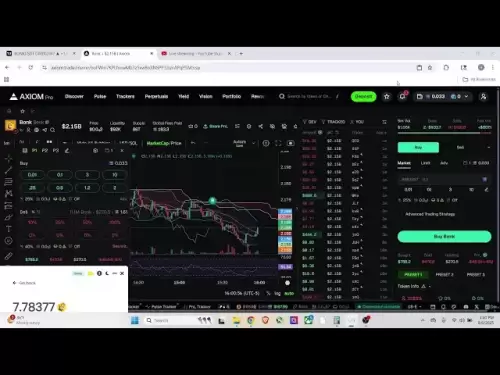-
 Bitcoin
Bitcoin $115100
1.27% -
 Ethereum
Ethereum $3675
2.71% -
 XRP
XRP $2.995
1.45% -
 Tether USDt
Tether USDt $1.000
0.02% -
 BNB
BNB $769.8
2.64% -
 Solana
Solana $168.0
3.25% -
 USDC
USDC $0.9999
-0.01% -
 TRON
TRON $0.3371
1.48% -
 Dogecoin
Dogecoin $0.2051
3.36% -
 Cardano
Cardano $0.7394
2.30% -
 Hyperliquid
Hyperliquid $38.15
0.42% -
 Stellar
Stellar $0.3966
-0.36% -
 Sui
Sui $3.486
2.93% -
 Chainlink
Chainlink $16.72
2.52% -
 Bitcoin Cash
Bitcoin Cash $568.0
4.36% -
 Hedera
Hedera $0.2440
2.59% -
 Ethena USDe
Ethena USDe $1.001
0.04% -
 Avalanche
Avalanche $22.16
2.06% -
 Litecoin
Litecoin $119.1
-0.73% -
 UNUS SED LEO
UNUS SED LEO $8.991
0.04% -
 Toncoin
Toncoin $3.232
-0.39% -
 Shiba Inu
Shiba Inu $0.00001233
2.82% -
 Uniswap
Uniswap $9.717
2.53% -
 Polkadot
Polkadot $3.664
1.85% -
 Dai
Dai $1.000
0.01% -
 Monero
Monero $281.2
-3.89% -
 Bitget Token
Bitget Token $4.350
1.55% -
 Cronos
Cronos $0.1428
5.07% -
 Pepe
Pepe $0.00001050
3.68% -
 Aave
Aave $262.3
3.54%
How to set a stop loss for MEXC contracts
When setting a stop loss for MEXC contracts, consider market volatility, risk tolerance, and contract size to determine the optimal stop loss price and type for your trading strategy.
Nov 11, 2024 at 06:54 am

How to Set a Stop Loss for MEXC Contracts
Introduction
A stop loss is an essential risk management tool for contract traders, allowing traders to automatically close their positions when the market moves against them, limiting potential losses. MEXC, a leading cryptocurrency derivatives exchange, provides a comprehensive range of contract trading options, including advanced stop loss features. This guide will explain the step-by-step process of setting a stop loss for MEXC contracts.
Steps to Set a Stop Loss for MEXC Contracts
1. Select the Contract
Open the MEXC trading platform and navigate to the Contracts section. Select the desired contract from the list of available options. Ensure that you have sufficient funds in your account to cover the initial margin and potential losses.
2. Set the Stop Loss Price
Once you select the contract, the order form will appear on the right-hand side of the screen. Under the "Stop Loss" field, input the desired stop loss price. The stop loss price represents the price level at which the contract will automatically close.
When setting the stop loss price, consider the following factors:
a. Market volatility: Higher volatility requires a wider stop loss to ensure the position is not closed prematurely due to market fluctuations.
b. Risk tolerance: The stop loss price should align with your individual risk appetite. Higher-risk traders may prefer a tighter stop loss, while more conservative traders may opt for a wider stop loss.
c. Contract size: The contract size determines the potential loss per tick movement. A smaller contract size allows for a tighter stop loss without risking significant capital.
3. Choose the Stop Loss Type
MEXC offers two types of stop loss orders:
- Conditional Stop Loss: Triggers a stop loss order only when the contract price touches or exceeds the specified stop loss price.
- Trigger Stop Loss: Triggers a stop loss order immediately when the contract price reaches the stop loss price.
4. Set the Target Price (Optional)
You can optionally set a target price for the stop loss order. The target price represents the price level at which the contract will be closed for profit. If the contract price reaches the target price before the stop loss price, the contract will be closed immediately.
5. Submit the Stop Loss Order
After specifying the stop loss price, type, and optional target price, submit the stop loss order by clicking the "Stop Limit" or "Sell All of Stop Market" button. The order will be placed and executed when the contract price meets the stop loss conditions.
6. Manage the Stop Loss
Once the stop loss order is activated, you can monitor its status in the "Active Orders" section. You can also modify or cancel the stop loss order before it is executed.
7. Consider the Risk
Setting a stop loss does not guarantee that you will avoid losses. The market can move rapidly and may even gap below the stop loss price, resulting in a larger loss. Always trade with caution and only risk capital that you can afford to lose.
Disclaimer:info@kdj.com
The information provided is not trading advice. kdj.com does not assume any responsibility for any investments made based on the information provided in this article. Cryptocurrencies are highly volatile and it is highly recommended that you invest with caution after thorough research!
If you believe that the content used on this website infringes your copyright, please contact us immediately (info@kdj.com) and we will delete it promptly.
- BlockDAG, Litecoin, and Cardano: Charting the Course in Crypto's Dynamic Waters
- 2025-08-07 09:09:06
- Fireverse Token: Igniting a Musical Revolution in Web3
- 2025-08-07 08:27:45
- Ethereum, L2 Withdrawals, and Decentralization: A New Yorker's Take
- 2025-08-07 08:32:33
- Avalanche vs. Ruvi AI: Daily Sales Tell a Story of Crypto Disruption
- 2025-08-07 06:29:35
- DeSoc: The Crypto to Buy Now for a Decentralized Future (and Maybe 43x Gains!)
- 2025-08-07 06:50:16
- Arctic Pablo Coin: Riding the Meme Coin Wave with a Deflationary Twist
- 2025-08-07 07:18:13
Related knowledge

Why is my Bitstamp futures position being liquidated?
Jul 23,2025 at 11:08am
Understanding Futures Liquidation on BitstampFutures trading on Bitstamp involves borrowing funds to open leveraged positions, which amplifies both po...

How to report Bitstamp futures for taxes?
Jul 30,2025 at 08:35am
Understanding Bitstamp Futures and Taxable EventsWhen trading Bitstamp futures, it’s essential to recognize that these financial instruments are treat...

Does Bitstamp offer inverse contracts?
Jul 23,2025 at 01:28pm
Understanding Inverse Contracts in Cryptocurrency TradingIn the realm of cryptocurrency derivatives, inverse contracts are a specific type of futures ...

What is the difference between futures and perpetuals on Bitstamp?
Jul 27,2025 at 05:08am
Understanding Futures Contracts on BitstampFutures contracts on Bitstamp are financial derivatives that allow traders to speculate on the future price...

How to find your Bitstamp futures trade history?
Jul 23,2025 at 08:07am
Understanding Bitstamp and Futures Trading AvailabilityAs of the current state of Bitstamp’s service offerings, it is critical to clarify that Bitstam...

Can I use a trailing stop on Bitstamp futures?
Jul 23,2025 at 01:42pm
Understanding Trailing Stops in Cryptocurrency TradingA trailing stop is a dynamic type of stop-loss order that adjusts automatically as the price of ...

Why is my Bitstamp futures position being liquidated?
Jul 23,2025 at 11:08am
Understanding Futures Liquidation on BitstampFutures trading on Bitstamp involves borrowing funds to open leveraged positions, which amplifies both po...

How to report Bitstamp futures for taxes?
Jul 30,2025 at 08:35am
Understanding Bitstamp Futures and Taxable EventsWhen trading Bitstamp futures, it’s essential to recognize that these financial instruments are treat...

Does Bitstamp offer inverse contracts?
Jul 23,2025 at 01:28pm
Understanding Inverse Contracts in Cryptocurrency TradingIn the realm of cryptocurrency derivatives, inverse contracts are a specific type of futures ...

What is the difference between futures and perpetuals on Bitstamp?
Jul 27,2025 at 05:08am
Understanding Futures Contracts on BitstampFutures contracts on Bitstamp are financial derivatives that allow traders to speculate on the future price...

How to find your Bitstamp futures trade history?
Jul 23,2025 at 08:07am
Understanding Bitstamp and Futures Trading AvailabilityAs of the current state of Bitstamp’s service offerings, it is critical to clarify that Bitstam...

Can I use a trailing stop on Bitstamp futures?
Jul 23,2025 at 01:42pm
Understanding Trailing Stops in Cryptocurrency TradingA trailing stop is a dynamic type of stop-loss order that adjusts automatically as the price of ...
See all articles

























































































